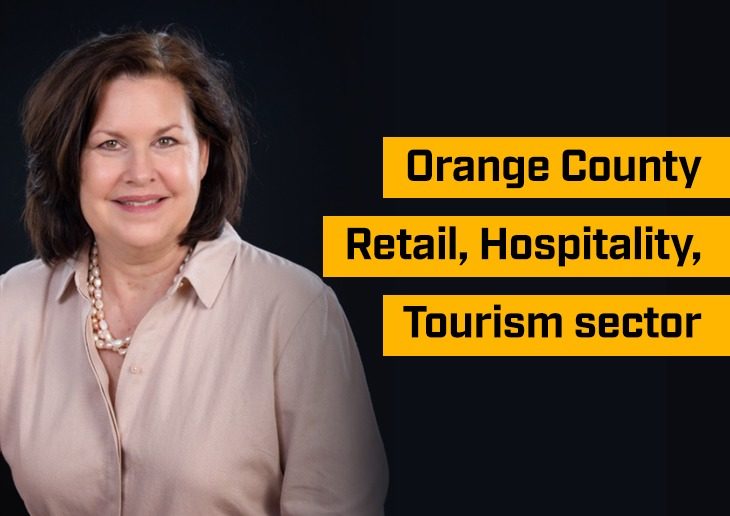Retail Recovery: Orange County’s Retail, Hospitality, and Tourism Sector with Regional Director Sheila Dufresne Industry Profile
November 24, 2020

The retail, hospitality, and tourism (RHT) sector has long been an essential part of Orange County’s economy—not only is Orange County the fourth most visited county in the US, a 2019 Orange County Visitors Association report noted that tourism sustained over 179,000 jobs in the county, making it the seventh largest employment sector in the region.
Those figures, of course, are from before the COVID-19 pandemic started impacting Orange County’s RHT industry.
“Our region recognizes how decimated these sectors are right now. They also know they will eventually rebound as the region rebounds,” says Sheila Dufresne, regional director of employer engagement for Orange County’s retail, hospitality, and tourism (RHT) sector.
As one of Orange County’s regional directors of employer engagement, Dufresne serves in a critical leadership role connecting community college career education programs with local industry and business community stakeholders in order to make sure students are getting the education they need to fill regional workforce needs.
“In this position, I am a mediator, a connector. My mission is to connect our programs and their unique traits with local employers,” she explains. “As a regional director, I don’t create curricula, but I do help inform it to better meet future workforce needs.”
Despite the excessive impact of COVID-19 on the RHT sector, there are several factors that give Dufresne hope.
“I’m heartened by the statistics that show that Orange County tourism numbers are by and large domestic,” says Dufresne. “Domestic travel is projected to come back first, and in fact some hotels are already seeing better than expected occupancy rates from local travelers and people looking for staycations.” She also notes that restaurants that have been able to expand outdoor seating, delivery services, and takeout have also seen more revenue.
Because of this, Dufresne is confident that when travel and hospitality open back up, retail and associated businesses will rebound as well. “When you realize that, historically, only 9.2 percent of OC tourists have been international, the path to recovery might not be as drawn out as some of the projects suggest,” she says.
Closures and restrictions have shaken Orange County’s economy, of course, but they have also had an impact on students and their programs. Almost overnight, classes moved online, and most work-based learning opportunities ceased.
“We’ve focused this year on supporting access to supplemental curricula,” says Dufresne. “Think about the students in the culinary programs. Typically, they are in the kitchen from early morning until noon. They can’t do that now, yet we didn’t have the capability of creating high quality video instruction for them.”
To address this issue, Dufresne helped interested schools acquire Rouxbe—a well-regarded online teaching platform for aspiring chefs—through the Bay Area Community College consortium.
This year in particular, Dufresne thinks the key for faculty and staff alike is their ability to pivot. Because students are working offsite, some culinary programs are providing ingredients for them to pick up, contact-free, so they can complete assignments at home. Others are giving the students gift cards for purchasing necessary supplies. Similar arrangements have been made across the region for students in the production classes of the fashion and merchandising programs who also have access to supplemental online curricula.
Looking for cross-sector projects is another area that captures Dufresne’s attention. She points to advanced transportation and logistics, a priority sector that doesn’t appear at first glance to overlap with RHT. Yet Dufresne sees a connection. With so much retail activity moving online, it’s clear that ecommerce is here to stay, she says. “Encouraging retail management and fashion merchandising students to qualify as certified supply chain management professionals (CSCMP) will expand their skills and make them more marketable.”
Providing students with work-based learning (WBL) opportunities has been a challenge, but there have been some successes. For example, culinary students typically fill their WBL requirement in the kitchens of local restaurants. Liability issues prevent them from doing that now, but students at Orange Coast are getting valuable experience by working in recovery kitchens and preparing meals for the food insecure within the community.
“There are a slew of community groups making an impact in the region, and we need to create pipelines for our students to tap into those opportunities in our communities,” she says.
Thrift stores, for example, are overwhelmed right now as people stuck at home clean out their closets and attics. “What if we had our fashion merchandising students bring their displays up to date and give the stores a more upscale vibe?” she muses. It’s an out-of-the-box opportunity that could be a win-win.
Looking Ahead
Early on in the pandemic, many people anticipated that the shutdown would last just a few months. At that time, experts were predicting a two-year recovery. Now, predictions for a full recovery in tourism and related sectors are somewhere between two and five years.
“Of course, it’s still a moving target and will depend on when theme parks are allowed to open and when large events and conventions can be held again,” says Dufresne. “But tourism, hospitality, and retail are here to stay. Beaches and attractions are what bring people here, and they’re not going away.”
And there is good data to support this—nine of California’s 11 major industry sectors gained jobs in October, with leisure and hospitality topping the list with an increase of 66,000 positions. In Orange County, unemployment was 7.5% in October, down from September’s 8.9%. Across the region, RHT jobs will play an important part in Orange County’s recovery.
“When people emerge from a crisis, there’s often the opportunity to recalibrate, to reflect on what is important,” says Dufresne. “I see some issues and inequities being discussed that were not discussed before, like guaranteed hours and benefits for part-time workers and issues of equity and access. Perhaps that means fewer jobs in the short term, but we’re hoping that could eventually mean better jobs in the long term.”
To learn more about the many fulfilling retail, tourism, and hospitality sector jobs in Orange County, please visit our RHT industry sector page.




